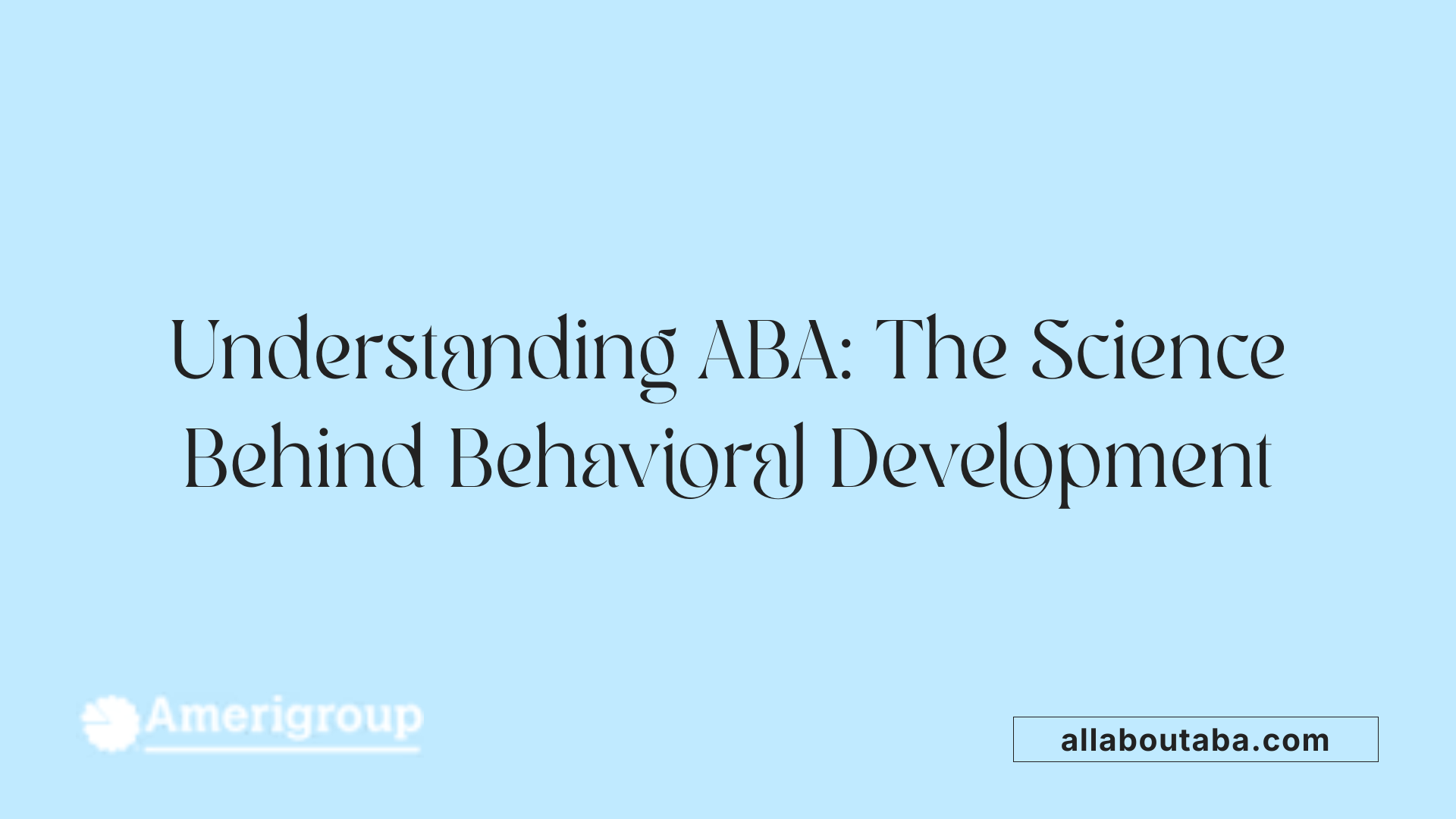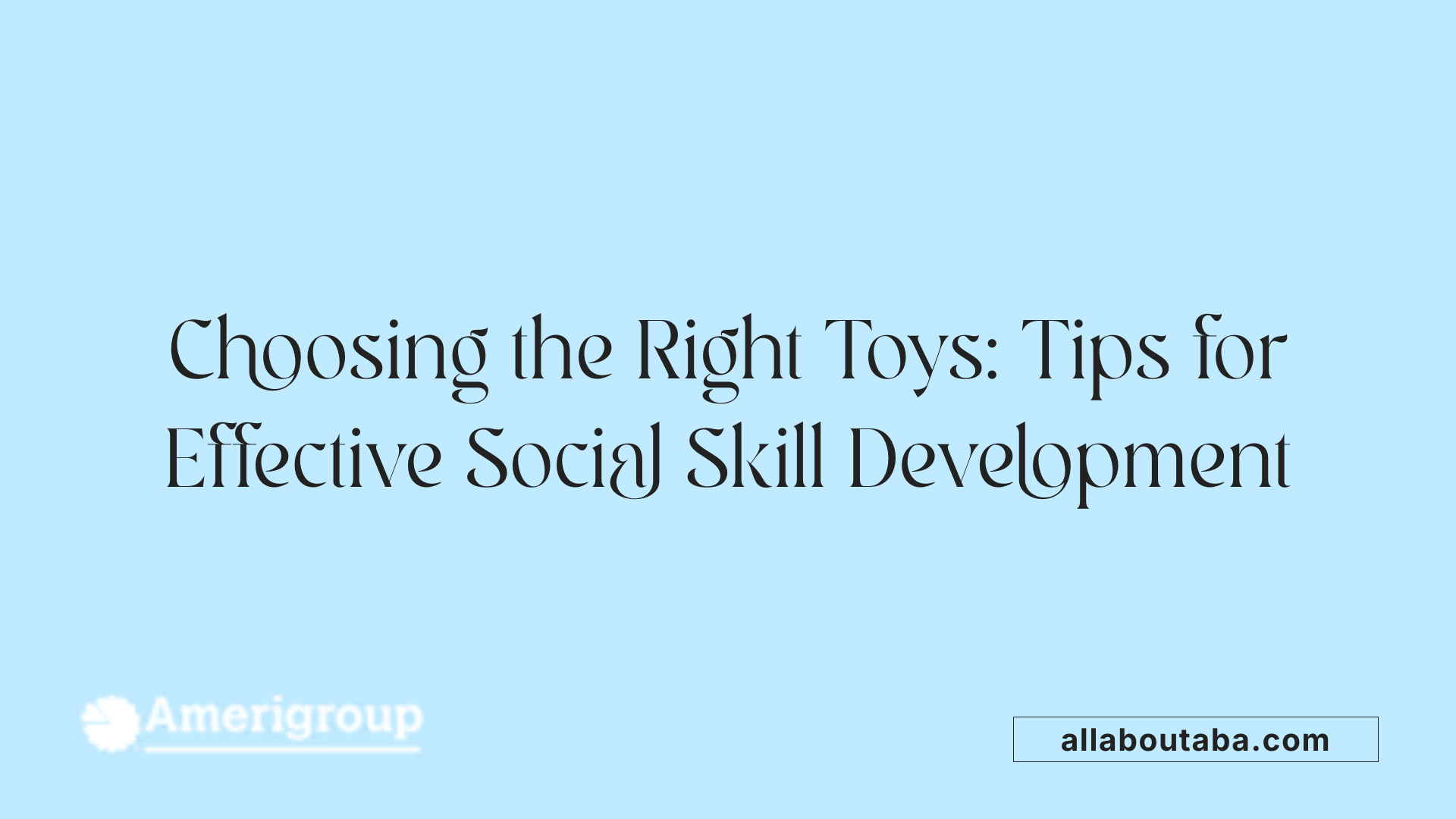Best Toys For Building Social Skills In Autism
Understanding the Role of Toys in Autism Therapy
Building social skills in children with autism can be challenging but achievable through targeted strategies. Applied Behavior Analysis (ABA) therapy provides a framework to develop communication and social interaction skills effectively. Toys designed to support ABA therapy play a crucial role in facilitating engagement, learning, and skill-building in a way that feels playful and motivating for children.
What is ABA Therapy and How Does It Support Social Skills in Autism?

Definition and principles of ABA therapy
Applied Behavior Analysis (ABA) therapy is a science-based approach that focuses on improving specific behaviors through carefully structured interactions and reinforcement. It seeks to increase positive behaviors—such as communication, social engagement, and daily living skills—while decreasing behaviors that may be challenging or harmful. ABA uses principles of learning, incorporating techniques like discrete trial training and naturalistic teaching, all customized to fit the needs of each child.
Use of ABA in autism treatment
ABA is widely recognized as an effective treatment for children with autism spectrum disorder. Early intervention programs grounded in ABA techniques are evidence-based and have demonstrated significant improvements in intellectual ability, language acquisition, and independence. The therapy emphasizes personalized goals, often integrating the child's interests to enhance engagement and learning. Importantly, modern ABA avoids outdated punitive practices and instead promotes positive reinforcement to encourage skill development.
Goals related to social skills
One of the main objectives of ABA therapy is to develop social skills that improve interaction and communication. These goals include fostering verbal expression, receptive language skills, sharing, turn-taking, and cooperation. Through structured activities and guided play, children practice these skills in engaging and meaningful ways, often using tools like role-play toys or interactive games. By systematically teaching social behaviors and encouraging repeated practice, ABA helps children with autism better connect with others and navigate social environments effectively.
Who Provides ABA Therapy and the Role of Families

Who Typically Provides ABA Therapy for Autism?
ABA therapy for children with autism is primarily delivered by qualified professionals such as Board-Certified Behavior Analysts (BCBAs), registered behavior technicians (RBTs), therapists, and educators trained in behavioral analysis. These experts often work within specialized autism clinics, organizations, schools, or offer independent services.
BCBAs play a crucial role by designing individualized treatment plans and supervising therapy to ensure measurable progress. Registered behavior technicians and therapists usually implement these plans directly during sessions.
Collaboration with Families
Families are an essential part of the ABA therapy process. Effective treatment relies on strong collaboration between professionals and caregivers to reinforce skills learned during therapy in everyday settings. Communication between therapists and families helps tailor interventions to each child's unique needs and environments.
Training Caregivers
Many ABA providers offer training and guidance to parents and caregivers so they can support the child's development at home. This training includes teaching specific ABA techniques, modeling desired behaviors, setting clear goals, and using positive reinforcement strategies. Empowering families with these skills helps maintain consistency and promotes generalization of learned behaviors beyond clinical sessions.
Common Goals of ABA Therapy: Enhancing Communication and Social Interaction

What are the common goals of ABA therapy in autism treatment?
ABA therapy primarily focuses on improving communication, social skills, and independence in children with autism. The therapy is customized to the child's unique needs and aims to develop functional, socially meaningful abilities, such as requesting help, self-care, and appropriate social engagement.
Improving communication
Communication challenges are common in children receiving ABA therapy. Toys like picture-based communication systems, dolls, role-playing sets, and interactive games encourage both expressive and receptive communication. These tools help children practice verbal expression and understand social responses within structured, engaging activities.
Fostering social skills
ABA therapy also targets critical social skills such as sharing, turn-taking, and cooperation. Board games, cooperative play sets, and pretend play toys are used to develop these abilities. Playing with these toys promotes interaction and helps children understand social norms and collaboration.
Developing independence
Enhancing daily living skills is another goal of ABA therapy, supporting the child's independence. Fine motor skills and coordination are developed through manipulatives, puzzles, and building blocks, which also create opportunities for social interaction. Cause-and-effect toys like push-and-pop devices, music toys, and mechanical toys teach problem-solving and communication in an interactive way.
Parents and therapists select ABA therapy toys carefully by matching them to the child's skill level, therapy objectives, and ensuring safety and engagement. When used at home, ABA toys can reinforce skills effectively if parents set clear goals, model behaviors, and give positive reinforcement, reinforcing the therapy's developmental progress.
How ABA Therapy Toys Facilitate Learning and Social Development

What Types of ABA Therapy Toys Are There?
ABA therapy employs a variety of toys tailored to address different developmental needs. Picture-based systems help children express themselves when words are challenging. Dolls and role-playing toys encourage social interaction and empathy. For fine motor skills and coordination, puzzles, building blocks, and manipulatives provide hands-on learning. Cause-and-effect toys like push-and-pop or musical instruments teach problem-solving and communication through immediate feedback.
How Do Children Learn Through Play?
Structured play is at the heart of ABA therapy toys. These toys create engaging environments where children practice targeted skills. By participating in cooperative play sets and board games, children learn turn-taking, sharing, and teamwork. Manipulatives not only develop motor skills but also open up chances for interaction and social engagement. The fun and repetitive nature of these toys fosters focus and motivation, crucial for learning.
How Are Communication and Interaction Encouraged?
Many children face challenges with verbal expression and social responses. ABA therapy toys bridge this gap by promoting both expressive and receptive communication. Picture cards and interactive games prompt children to recognize and respond to social cues. Role-playing scenarios with dolls or pretend play sets simulate real-life conversations and interactions. Positive reinforcement during play encourages ongoing practice, helping children build confidence and social competence.
| Toy Type | Purpose | Examples |
|---|---|---|
| Picture-based Systems | Support communication | Picture cards, visual aids |
| Dolls & Role-play | Encourage social skills | Dolls, pretend play sets |
| Fine Motor Toys | Develop coordination & social play | Puzzles, building blocks |
| Cause-and-Effect Toy | Teach problem-solving | Push-and-pop, music toys |
Selecting the Best Toys for Social Skill Building in Autism

Matching Toys to the Child's Skill Level
Choosing toys that align with a child's current abilities is crucial for effective ABA therapy. Toys should neither be too simple nor too complex, but offer just the right level of challenge to promote learning. For instance, picture-based communication systems are beneficial for children starting to develop verbal skills, while role-playing toys suit those ready to practice social interactions more deeply.
Safety and Durability
Parents and therapists must prioritize safety and durability when selecting toys. Toys should be made from non-toxic materials and free from small parts that could pose choking hazards. Durable toys withstand repeated use during therapy sessions, ensuring the child can engage consistently without frustration from broken items.
Engagement and Therapy Goals
Engaging toys that capture a child’s interest are essential to maintaining motivation during therapy. The chosen toys should directly support therapy goals such as improving communication, cooperation, or problem-solving. For example, board games encourage turn-taking and sharing, while cause-and-effect toys help with understanding consequences and verbal expression. Guided play using these toys allows therapists and parents to model behaviors and reinforce learning effectively.
Role of Specific Toy Types in Developing Social and Communication Skills
Picture-based communication systems
Picture-based communication systems are valuable tools in ABA therapy, especially for children who struggle with verbal expression. These toys use visuals to represent words and concepts, helping children to both express themselves and understand others. This visual support bridges gaps in communication, allowing children to participate more actively in social settings.
Role-playing and pretend play toys
Role-playing and pretend play toys, such as dolls and themed play sets, are effective in encouraging social interaction and expressive communication. They offer structured scenarios where children can practice social behaviors, turn-taking, and conversational skills in an imaginative, low-pressure environment. Such play fosters empathy and helps children understand social cues.
Board games and cooperative play sets
Board games and cooperative play sets provide opportunities for children to develop core social skills like sharing, turn-taking, and cooperation. Engaging in these activities requires communication, following rules, and joint decision-making, which are essential components of social interaction. Using these toys in ABA therapy aligns with reinforcing positive social behaviors through fun and interactive means.
Toys Supporting Fine Motor Skills and Their Impact on Social Interaction
What Types of Toys Support Fine Motor Skills?
Toys such as manipulatives, puzzles, and building blocks are especially effective for developing fine motor skills in children. These toys require precise hand movements and coordination, promoting manual dexterity and control. For example, puzzles involve fitting pieces together, which demands careful finger manipulation, while building blocks encourage stacking and balancing.
How Do These Toys Aid Fine Motor Coordination?
Engaging with these toys helps children strengthen small muscle groups in their hands and fingers. This type of practice improves hand-eye coordination and prepares children for daily tasks like writing, buttoning clothes, or using utensils. Fine motor coordination is essential for children to gain independence and complete everyday activities confidently.
In What Ways Do Fine Motor Toys Enhance Cooperative Play?
Beyond individual skill-building, manipulatives and building blocks naturally foster cooperative play. Children often work together to build structures or solve puzzles, encouraging turn-taking, collaboration, and communication. This shared activity not only enhances motor skills but also supports important social skills like sharing, teamwork, and patience.
Together, these toys serve as engaging tools that promote both physical coordination and meaningful social interactions, integral components in ABA therapy for children.
Measuring Progress and Reinforcing Social Behavior with ABA Toys at Home
How is the effectiveness of ABA therapy measured?
The effectiveness of ABA therapy is measured through careful tracking of behavioral improvements over time. Parents and therapists collect data on specific behaviors, such as communication attempts, social interactions, or daily living skills. This data often includes frequency, duration, or intensity of targeted actions. Visual aids like charts and graphs help illustrate patterns of progress, making it easier to see where the child is improving.
Regular assessments and data analysis ensure that interventions with ABA toys are producing positive changes. Sometimes, techniques like alternating treatments allow caregivers to confirm that the observed improvements are directly due to the ABA therapy activities.
Parental involvement and positive reinforcement
Parents play a crucial role when using ABA therapy toys at home. By setting clear goals for their child's development, they can use these toys to reinforce skills learned during therapy sessions. Modeling desired behaviors and celebrating small successes encourages children to keep practicing.
Positive reinforcement, such as praise or rewards, helps motivate children and increases the chance that helpful behaviors will be repeated. This creates a supportive environment where learning and social interaction become enjoyable.
Using toys for guided play and skill reinforcement
ABA therapy toys are especially effective when used in guided play sessions. Parents can choose toys that match their child's skills and therapy goals, ensuring that activities challenge the child just enough to promote growth.
Examples include picture-based communication systems that support expressive language, or cooperative play sets that teach sharing and turn-taking. Using building blocks or puzzles can also enhance fine motor skills while fostering social engagement.
By combining structured guidance with engaging toys, parents can make therapy sessions feel more like fun playtime, reinforcing important skills in natural settings that encourage generalization of learned behaviors.
Bringing It All Together for Meaningful Social Growth
ABA therapy offers a solid foundation for helping children with autism develop essential social skills. Choosing and using the right toys tailored to a child's unique needs can make learning enjoyable, motivating, and effective. Through collaboration between specialists and families, and with careful selection of toys that foster communication, cooperation, and fine motor abilities, children can achieve meaningful progress in social interaction. Consistent tracking and positive reinforcement ensure that these gains translate into real-life improvements, supporting a happier, more connected future for children on the autism spectrum.
References
- Best ABA Therapy Toys for Communication and Social Skills
- ABA Therapy Goals: 25 Practical Examples & Timelines
- Applied Behavior Analysis (ABA)
- Applied Behavior Analysis (ABA)
- Treatment and Intervention for Autism Spectrum Disorder
- Efficacy of Interventions Based on Applied Behavior ...
- The effectiveness of applied behavior analysis program ...
- Applied Behavior Analysis (ABA)
Other articles
Recent articles

Understanding Pragmatic Language Difficulties In Autism

The Role Of Dieticians In Autism Support Teams

The Science Of Brain Connectivity In Autism

Best Toys For Building Social Skills In Autism

Cultural Perspectives On Autism Around The World

Autism And Creative Arts As Emotional Expression Tools

Developing Emotional Regulation Skills In Autistic Teens

Best Sensory-Friendly Lighting Solutions For Autism

Cognitive Behavioral Therapy Adaptations For Autism

Best Practices For Autism-Friendly Movie Screenings

Autism And Eating Challenges Beyond Picky Eating

Best Practices For Autism-Friendly Public Transport Design

Best Ways To Foster Collaboration Between Parents And Schools For Autism Support

Supporting Autistic Children During Transitions Between Activities

The Role Of Teachers In Fostering Autism Peer Acceptance

Using Art Therapy To Support Children With Autism

Autism And Strategies For Addressing Sensory Defensiveness

Autism And The Benefits Of Structured Leisure Activities

How To Support Autistic Students During Exam Season

Autism And Goal Setting For Personal Growth

How To Use Gamification In Autism Learning Programs

How Schools Can Reduce Bullying Of Autistic Students

Early Intervention Strategies For Autism Spectrum Disorder

The Role Of Therapists In Autism Life Skills Coaching

How To Support Autistic Individuals In Crisis Situations

Autism And Self-Care Routines For Stress Management

Understanding Echolalia And Its Role In Autism Communication

Autism And Fine Arts Education Benefits

The Impact Of Multisensory Learning On Autism Education

How Family Counseling Supports Autism Household Dynamics

Best Practices For Inclusive Playgrounds For Autism

Best Practices For Autism-Friendly Shopping Centers

How Autism Affects Fine Motor Skill Development

Best Ways To Introduce Sensory Activities Into Daily Routines

How Sports Teams Can Be Inclusive Of Autistic Players

Autism And Strategies For Building Workplace Resilience

Autism And The Impact Of Hormonal Changes During Puberty

How To Support Autistic Students In Foreign Language Classes

Best Ways To Teach Money Skills To Teens With Autism

Supporting Siblings Of Children With Autism

Autism And Co-Occurring Gastrointestinal Disorders

The Role Of Art Projects In Autism Sensory Integration

How Schools Can Incorporate Sensory Break Spaces

Best Practices For Autism Sensory Regulation At School

Autism And Strategies For Teaching Organizational Skills

Understanding The Relationship Between Autism And Anxiety Disorders

Autism And Life Planning For Long-Term Care

Exploring Visual Supports In Autism Education

Ways To Encourage Social Interaction In Children With Autism

The Connection Between Autism And Dyscalculia

The Role Of Occupational Therapy In Transition Planning For Autism

The Role Of Physical Therapists In Autism Motor Skills Support

How To Teach Decision-Making Skills To Autistic Young Adults

The Connection Between Autism And Epilepsy

Best Practices For Transitioning Autistic Children Into New Schools

Autism And Time Management Challenges In Adulthood

The Role Of Visual Arts In Autism Communication Development

How To Address Tactile Defensiveness In Autism

Best Practices For Telehealth Autism Therapy

How To Help Autistic Children Develop Friendship Skills

How Schools Can Support Autistic Students In Career Prep

Best Strategies For Autism-Friendly Event Planning

Understanding Noncontingent Reinforcement In Autism Behavior Plans

How Drama Therapy Benefits Autistic Individuals

Best Practices For Autism-Friendly Fitness And Recreation Centers

Best Ways To Promote Healthy Social Media Use For Autistic Teens

How To Help Autistic Children Cope With Public Speaking

Autism And Strategies For Managing Unexpected Changes

Best Podcasts About Autism For Parents And Educators

Autism And The Impact Of Seasonal Changes On Behavior

The Role Of Diet In Managing Co-Occurring Conditions With Autism

Sleep Challenges In Autism And Practical Solutions

Best Ways To Build Daily Routines For Autistic Children

Best Practices For Supporting Autistic Entrepreneurs

Autism And Strategies For Navigating Large Social Gatherings

Adaptive Sports And Recreational Activities For People With Autism

Autism And The Benefits Of Story-Based Learning Activities

Understanding The Role Of Play In Autism Development

Autism And The Impact Of Environmental Noise On Learning

How To Create Autism-Friendly Community Spaces

Autism And Chronic Health Conditions: What To Know

The Role Of Care Managers In Autism Life Planning

How To Teach Social Boundaries To Autistic Children

How Autistic Individuals Experience Empathy Differently

How To Support Autistic Employees In Remote Work Settings

Autism And The Relationship Between Motor Skills And Learning

How To Create Community Resource Guides For Autism Families

How To Teach Daily Living Skills To Autistic Teens

Autism And The Impact Of Mind-Body Practices On Stress Reduction

Autism And The Benefits Of Outdoor Group Activities

How To Create Autism-Friendly Sensory Paths In Schools

Best Practices For Autism-Friendly Park And Recreation Areas

Autism And Strategies For Reducing School Refusal

Supporting Autistic Individuals In Public Speaking

The Role Of Diet In Managing Autism Symptoms

The Benefits Of Gardening Clubs For Autism Social Development

How To Prepare Autistic Children For Dental Visits

Autism And Employment: Career Paths That Work

Best Practices For Autism-Friendly Hotels And Lodging

The Impact Of Screen Time On Autism Development
We’re All About You, Your Family, and Your Child

